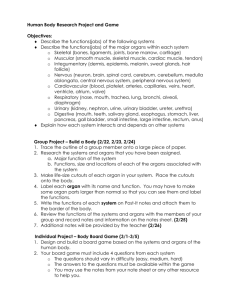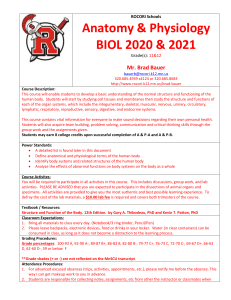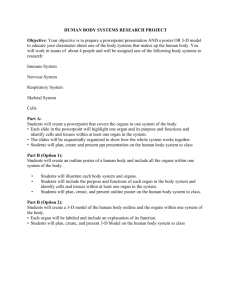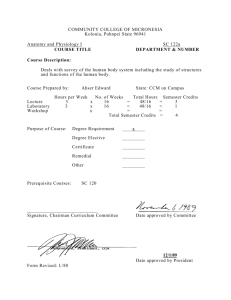C-TEC MEDICAL ASSISTANT Course Description: Anatomy and
advertisement
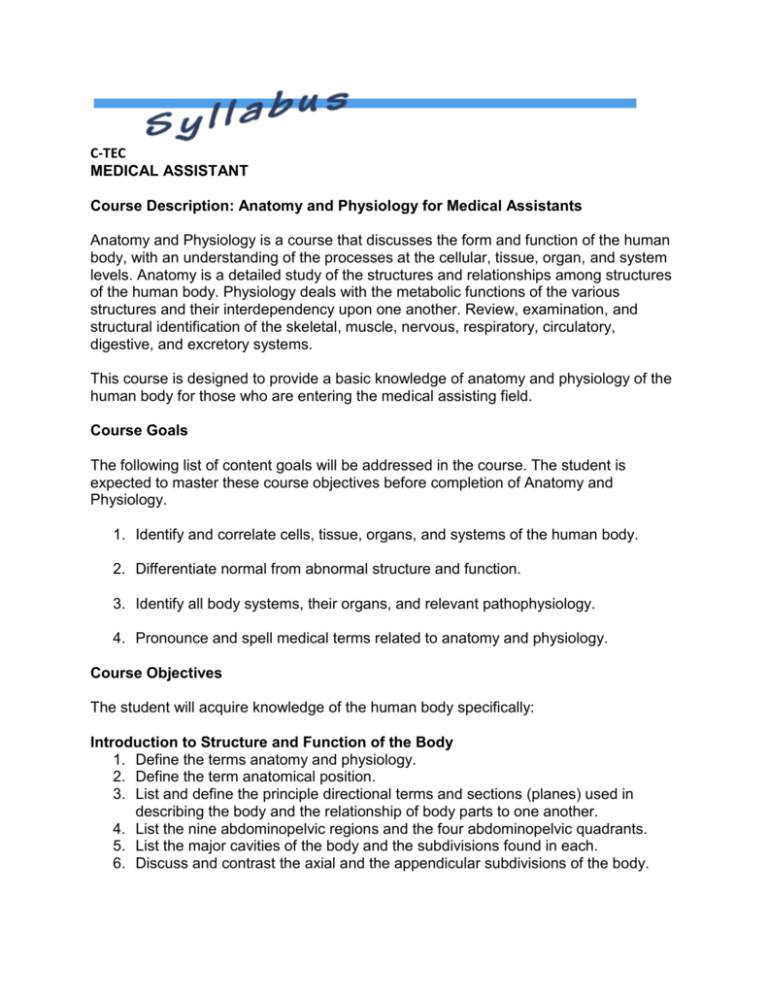
C-TEC MEDICAL ASSISTANT Course Description: Anatomy and Physiology for Medical Assistants Anatomy and Physiology is a course that discusses the form and function of the human body, with an understanding of the processes at the cellular, tissue, organ, and system levels. Anatomy is a detailed study of the structures and relationships among structures of the human body. Physiology deals with the metabolic functions of the various structures and their interdependency upon one another. Review, examination, and structural identification of the skeletal, muscle, nervous, respiratory, circulatory, digestive, and excretory systems. This course is designed to provide a basic knowledge of anatomy and physiology of the human body for those who are entering the medical assisting field. Course Goals The following list of content goals will be addressed in the course. The student is expected to master these course objectives before completion of Anatomy and Physiology. 1. Identify and correlate cells, tissue, organs, and systems of the human body. 2. Differentiate normal from abnormal structure and function. 3. Identify all body systems, their organs, and relevant pathophysiology. 4. Pronounce and spell medical terms related to anatomy and physiology. Course Objectives The student will acquire knowledge of the human body specifically: Introduction to Structure and Function of the Body 1. Define the terms anatomy and physiology. 2. Define the term anatomical position. 3. List and define the principle directional terms and sections (planes) used in describing the body and the relationship of body parts to one another. 4. List the nine abdominopelvic regions and the four abdominopelvic quadrants. 5. List the major cavities of the body and the subdivisions found in each. 6. Discuss and contrast the axial and the appendicular subdivisions of the body. 7. Explain the meaning of the term homeostasis and give an example of a typical homeostatic mechanism. Organ Systems of the Body 1. Define and contrast the terms organ and organ system. 2. List the 11 major organ systems of the body. 3. Identify and locate the major organs of each major organ system. 4. Briefly describe the major functions of major organ systems. The Skeletal System 1. List and discuss the generalized functions of the skeletal system. 2. Identify the major anatomical structures found in a typical long bone and discuss bone formation. 3. Identify the two major subdivisions of the skeleton and list the bones found in each area. 4. List and compare the major types of joints found in the body and give an example of each type. The Muscular System 1. List and locate in the body, and compare the structure and function of the three major types of muscle tissue. 2. Discuss how a muscle is stimulated, and compare the major types of skeletal muscle contractions. 3. Name and identify on a model or diagram, and give the function of the major muscles of the body discussed in this chapter. 4. List and explain the most common types of movement produced by skeletal muscles. Blood 1. Describe the primary function of blood. 2. Describe the characteristics of blood plasma. 3. List the formed elements of blood, and identify the most important of each. 4. Define the following medical terms associated with blood: Hematocrit, leukocytes, leukopenia, polycythemia, sickle cell, phagocytosis, acidosis, thrombosis, erythroblastosis fetalis, serum, fibrinogen, Rh factor, and anemia The Circulatory System 1. Discuss the location, size, and position of the heart in the thoracic cavity and identify the heart chambers, sounds, and valves. 2. Trace the blood through the heart and compare the functions of the heart chambers on the right and left sides. 3. List anatomical components of the heart conduction system. 4. Explain the relationship between blood vessel structure and function. The Lymphatic System & Immunity 1. Describe the generalized functions of the lymphatic system and list the primary lymphatic structures. 2. Define and compare nonspecific and specific immunity, inherited and acquired immunity, and active and passive immunity. 3. Discuss the major types of immune system. The Respiratory System 1. Discuss the generalized functions of the respiratory systems. 2. List the major organs of the respiratory system and describe the function of each. The Digestive System 1. List in sequence each of the component parts or segments of the alimentary canal from the mouth to the anus and identify the accessory organs of digestion. 2. Define and contrast mechanical and chemical digestion. 3. Define peristalsis, bolus, chyme, jaundice, ulcer, and diarrhea. Nutrition & Metabolism 1. Define and contrast catabolism and anabolism. 2. Describe the metabolic roles of carbohydrates, fats, proteins, vitamins, and minerals. The Urinary System 1. Identify the major organs of the urinary system and give the generalized function of each. 2. Name the parts of a nephron and describe the role each component plays in the formation of urine. 3. Explain how the kidneys act as vital organs in maintaining homeostasis. Fluid & Electrolyte Balance 1. List, describe, and compare the body fluid components and their subdivisions. 2. Discuss avenues by which water enters and leaves the body and the mechanisms that maintain fluid balance. 3. Discuss the nature and importance of electrolytes in body fluid. 4. Give examples of common fluid imbalances. The Nervous System 1. List the organs and divisions of the nervous system and describe the generalized functions of the system as a whole. 2. Identify the major types of cells in the nervous system and discuss the function of each. 3. Identify the major anatomical components of the brain and spinal cord, and briefly comment on the function of each. 4. Compare and contrast spinal cord and cranial nerves. 5. Discuss the anatomical and functional characteristics of the divisions of the autonomic nervous system. The Senses 1. Classify sense organs as special or general, and explain the basic differences between the groups. 2. Discuss how a stimulus is converted into a sensation. 3. Discuss the general sense organs and their functions. 4. Describe the structure of the eye and the functions of its components. 5. Discuss the anatomy of the ear and its sensory function in hearing and equilibrium. 6. Discuss the chemical receptors and their functions. The Integumentary System & Body Membranes 1. Classify and compare the structure of, and give examples of each type of body membrane. 2. Describe the structure and function of the epidermis and dermis. 3. List and briefly describe each accessory organ of the skin. 4. List and discuss the three primary functions of the Integumentary system. The Endocrine System 1. Identify and locate the primary endocrine glands and list the major hormones produces by each gland. 2. Identify the principal functions of each major endocrine hormone, and describe the conditions that may result from hyposecretion or hyposecretion. The Reproductive Systems 1. List the essential and accessory organs of the male and female reproductive systems and give the generalized function of each. 2. Identify and describe the structures that constitute the external genitals in both sexes. Growth & Development 1. Discuss the concept of development as a biological process characterized by continuous modification and change. 2. Discuss the major development changes characteristic of the prenatal stage of life from fertilization to birth. 3. List and discuss the major developmental changes characteristic of the four postnatal periods of life. 4. Discuss the effects of aging on the major body organ systems.


